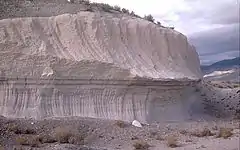Bishop Tuff
The Bishop Tuff is a welded tuff that formed 767,100 ± 900 years ago as a rhyolitic pyroclastic flow during the eruption that created the Long Valley Caldera.[1] Large outcrops of the tuff are located in Inyo and Mono Counties, California, United States.
| Bishop eruption | |
|---|---|
 Two layers of the Bishop Tuff: lower layer was from ashfall, upper layer was from the main pyroclastic flow. | |
| Volcano | Long Valley Caldera |
| Date | 767,100 ± 900 years ago |
| Type | Ultra-Plinian |
| Location | California, United States 37°43′00″N 118°53′03″W |
| VEI | 7 |
.png.webp) Map of the Long Valley Caldera, with Bishop Tuff outlined. | |
Modern exposure
The Bishop Tuff caps a volcanic plateau in the northern Owens Valley. The tableland formation is located east of U.S. Route 395 and west of the Nevada stateline, sitting northwest of Bishop and southeast of Crowley Lake and Mammoth Lakes. Another part of the flow is south of Mono Lake, and surrounding the Mono-Inyo Craters.
Deposits of Bishop Tuff in this area cover nearly 2,200-square-kilometer (850 sq mi), and range in thickness from 150-meter (490 ft) to 200-meter (660 ft).
The Owens River cuts through the Volcanic Tableland, an ignimbrite plateau that is a principal sector of the Bishop Tuff outflow sheet. Erosion of the plateau by the Owens River has created the Owens River Gorge.[2]
See also
References
- Crowley, J.L.; Schoene, B.; Bowring, S.A. (December 2007). "U-Pb dating of zircon in the Bishop Tuff at the millennial scale". Geology. 35 (12): 1123–1126. Bibcode:2007Geo....35.1123C. doi:10.1130/G24017A.1.
- Hildreth, Wes; Fierstein, Judy (2016). Long Valley Caldera Lake and Reincision of Owens River Gorge. United States Geological Survey. p. 2. ISSN 2328-031X.
